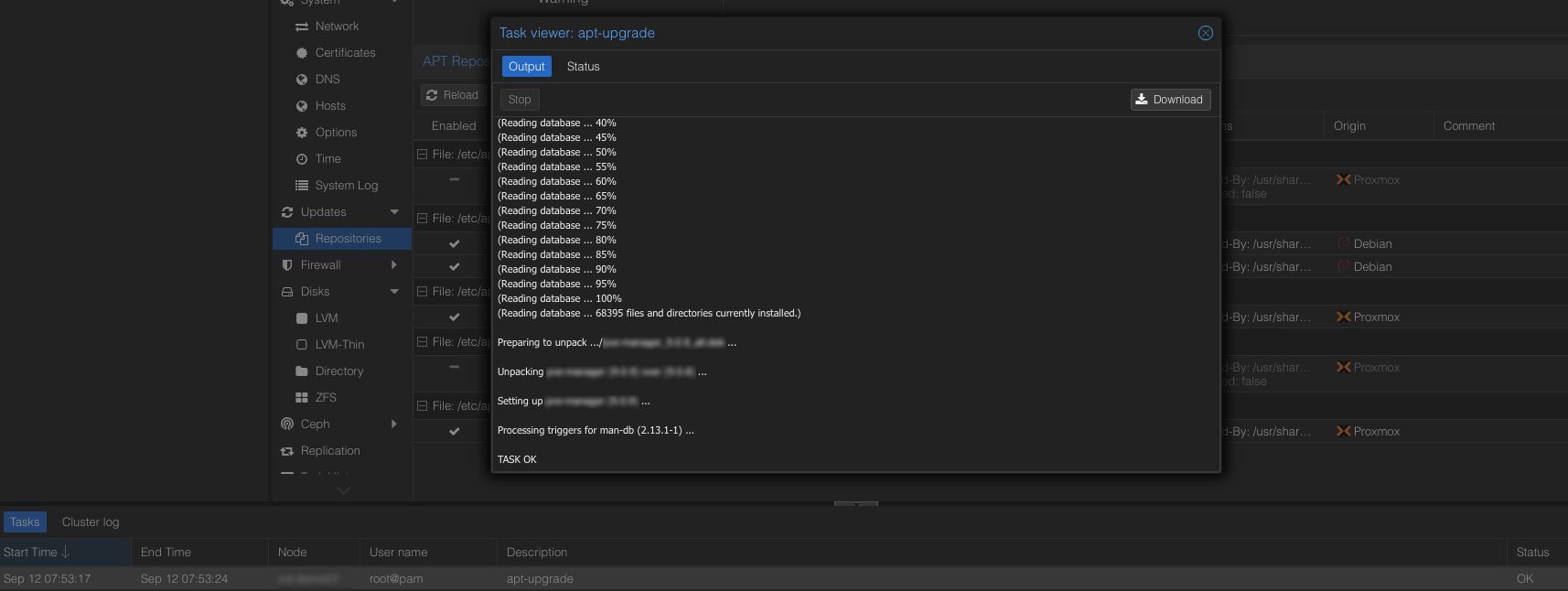If you're a #PHP developer who uses #DDEV you might be interested in checking out what I've been up to making @codeenigma's ce-deploy ( #Ansible stack for app deployment) work inside DDEV, both already support #drupal, #symfony, #wordpress, etc. It allows developers to test their server deployments locally, with the same tools as their server environments, before running them for real. 😎
If you're a #PHP developer who uses #DDEV you might be interested in checking out what I've been up to making @codeenigma's ce-deploy ( #Ansible stack for app deployment) work inside DDEV, both already support #drupal, #symfony, #wordpress, etc. It allows developers to test their server deployments locally, with the same tools as their server environments, before running them for real. 😎
It's almost as if Puppet, Chef, and CFEngine had become rude words.
It started with some Docker containers on a Raspberry Pi, then it was two Pis… now I run a two-node K8s cluster on some Intel NUCs with dedicated/ext. failover DNS. What a rabbit hole 😅
On the other hand you gain such a huge amount of devops an infrastructure knowledge - for me it was worth putting in weeks of effort. And you have a resilient base of hosting your services, that noone can just take away or up subscription pricing.
I am currently writing multiple posts about it. Will publish the first one soon.
Finally I found time to write down some insights into my #homelab, #selfhosting adventures and how I run things unconnected to big tech platforms.

A general look insight can be found here https://www.codedge.de/hlab/

If you want to read some technical details about some inner workings, follow my article series around my homelab look here https://www.codedge.de/tags/hlab/
I am going to write some more in-depth articles in the next couple of days.
NEW BLOGPOST!
The Onionspray Ansible role version 3 has just been released, and with it, I've put together this article about @torproject , online privacy, and related concepts. If you'd like to learn more about Tor onion services, and how you can easily deploy your own with Onionspray and Ansible, be sure to take a look!
https://zoug.fr/deploy-tor-onion-service-onionspray-ansible/
Feel free to leave a comment on it by replying to this post :)
NEW BLOGPOST!
The Onionspray Ansible role version 3 has just been released, and with it, I've put together this article about @torproject , online privacy, and related concepts. If you'd like to learn more about Tor onion services, and how you can easily deploy your own with Onionspray and Ansible, be sure to take a look!
https://zoug.fr/deploy-tor-onion-service-onionspray-ansible/
Feel free to leave a comment on it by replying to this post :)
Earlier this year, I developed "ansible_jailexec", a modern Ansible connection plugin that can manage FreeBSD Jails via jexec via the host (incl. transparent file copy into the jails filesystem). All released under a BSD license.
That way, you can automate FreeBSD Jails via Ansible, even when they have no ssh or network connectivity.
On Codeberg: https://codeberg.org/Larvitz/ansible_jailexec
On GitHub: https://github.com/chofstede/ansible_jailexec/
The connection-plugin comes as a single python file (jailexec.py) and comes with Unit tests and internal safety checks.
Maybe someone finds it useful.
Happy automating  🙂
🙂
#freebsd #ansible #automation #bsd #automation #opensource #foss #jails
Earlier this year, I developed "ansible_jailexec", a modern Ansible connection plugin that can manage FreeBSD Jails via jexec via the host (incl. transparent file copy into the jails filesystem). All released under a BSD license.
That way, you can automate FreeBSD Jails via Ansible, even when they have no ssh or network connectivity.
On Codeberg: https://codeberg.org/Larvitz/ansible_jailexec
On GitHub: https://github.com/chofstede/ansible_jailexec/
The connection-plugin comes as a single python file (jailexec.py) and comes with Unit tests and internal safety checks.
Maybe someone finds it useful.
Happy automating  🙂
🙂
#freebsd #ansible #automation #bsd #automation #opensource #foss #jails
The latest edition of the #Ansible Bullhorn is out! We're #hiring on the Ansible community engineering team so be sure to check out this week's edition!
https://forum.ansible.com/t/the-bullhorn-206/44740
Are you in #tech and running your own #Fediverse instance? You might want to join an Activity Pub relay instance!
My relay at https://fedi-relay.gyptazy.com has currently 139 instances connected, mostly tech related sharing the same mindset and interests like #Linux, #BSD, #Ansible, #Proxmox, #Coding, and many more! You can easily join from your instance when using #Pleroma, #snac ( #snac2), #Mastodon and its forks 🙂
#fedi #fediworld #fedicommunity #community #FreeBSD #OpenBSD #NetBSD #homelab #Python #Debian #RockyLinux #Feditips
Are you in #tech and running your own #Fediverse instance? You might want to join an Activity Pub relay instance!
My relay at https://fedi-relay.gyptazy.com has currently 139 instances connected, mostly tech related sharing the same mindset and interests like #Linux, #BSD, #Ansible, #Proxmox, #Coding, and many more! You can easily join from your instance when using #Pleroma, #snac ( #snac2), #Mastodon and its forks 🙂
#fedi #fediworld #fedicommunity #community #FreeBSD #OpenBSD #NetBSD #homelab #Python #Debian #RockyLinux #Feditips
#sysAdmin #Niche #Ansible #Debian
Utiliser des paquetages de Debian unstable via Ansible : https://www.bortzmeyer.org/ansible-debian-unstable.html
I think the hardest thing for me to convey to students learning #ansible is one of the points in the Ansible best practices document:
"Generous use of whitespace to break things up, and use of comments (which start with ‘#’), is encouraged."
I even explain that the use of the large key on the keyboard with which an empty line is created is almost free of charge to use!
I think the hardest thing for me to convey to students learning #ansible is one of the points in the Ansible best practices document:
"Generous use of whitespace to break things up, and use of comments (which start with ‘#’), is encouraged."
I even explain that the use of the large key on the keyboard with which an empty line is created is almost free of charge to use!
Hey #Proxmox community! I would like to hear your thoughts on how you usually update your Proxmox nodes and clusters. How do you handle minor Proxmox and #Debian package upgrades with #APT?
What would you think about a new API endpoint that lets you run unattended upgrades with a simple call like:
/nodes/{node_name}/apt/upgrade
At the moment you need to use the node’s HTML5 console to perform upgrades. Other methods exist such as running unattended Debian upgrade scripts, using patch management tools like #Spacewalk or #QualvoSec, or automating the process with #Ansible over SSH. My idea is to have an API based solution that relies on Proxmox authentication and authorization. This would also allow third party tools such as #ProxLB to provide automated patch management and even handle guest rebalancing in a way that is similar to DRS without requiring direct SSH access.I have already been running this approach on several internal clusters since the release of PVE 8 without issues. Now I am interested to hear if you would use unattended upgrades in general or if you are already running them today.
#Linux #OpenSource #PatchManagement #Security #DevOps #Automation #Ansible #PVE #PVE8 #PVE9
Hey #Proxmox community! I would like to hear your thoughts on how you usually update your Proxmox nodes and clusters. How do you handle minor Proxmox and #Debian package upgrades with #APT?
What would you think about a new API endpoint that lets you run unattended upgrades with a simple call like:
/nodes/{node_name}/apt/upgrade
At the moment you need to use the node’s HTML5 console to perform upgrades. Other methods exist such as running unattended Debian upgrade scripts, using patch management tools like #Spacewalk or #QualvoSec, or automating the process with #Ansible over SSH. My idea is to have an API based solution that relies on Proxmox authentication and authorization. This would also allow third party tools such as #ProxLB to provide automated patch management and even handle guest rebalancing in a way that is similar to DRS without requiring direct SSH access.I have already been running this approach on several internal clusters since the release of PVE 8 without issues. Now I am interested to hear if you would use unattended upgrades in general or if you are already running them today.
#Linux #OpenSource #PatchManagement #Security #DevOps #Automation #Ansible #PVE #PVE8 #PVE9
A new BSDCan video has been posted:
Automating My FreeBSD Lab: From Setup to Daily Use with Ansible & Salt by Roller Angel
Automating My FreeBSD Lab: From Setup to Daily Use with Ansible & Salt
Abstract
Managing multiple FreeBSD machines can be time-consuming, but automation makes it effortless. In this talk, I will demonstrate how I use Ansible to set up my FreeBSD lab and Salt to maintain and scale it across multiple machines—including how I configured a second FreeBSD laptop with just SSH access.
Attendees will see how automation enables:
Seamless FreeBSD system setup using Ansible.
Automated configuration management with Salt.
Effortless scaling to new machines, reducing manual setup to a few commands.
By the end of the talk, attendees will understand how to leverage Ansible and Salt to build a reproducible and maintainable FreeBSD infrastructure.
Intended Audience
FreeBSD users interested in automating system setup and maintenance.
System administrators managing multiple FreeBSD machines.
Anyone curious about Ansible and Salt for FreeBSD automation.
Attendees should have basic FreeBSD knowledge, but no prior experience with automation tools is required.
For more information, please visit:
https://www.bsdcan.org/2025/
- and -
https://www.bsdcan.org/2025/timetable/timetable-Automating-My-FreeBSD.html


